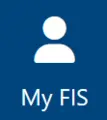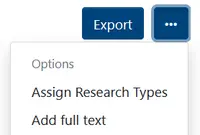Publishing in the FIS
The Research Information System (FIS) is the institutional repository of the University of Bamberg, where researchers of the university can publish directly in Open Access (first publication, Diamond Open Access) or make their already published research contributions available in parallel and without a payment barrier (second publication, Green Open Access).
As part of its Open Access Declaration the university management encourages the university's researchers to publish publications and research results in the FIS as original work or as pre- or postprints (see also Open Access Publishing).
First Publication
In the Research Information System (FIS) documents such as the following are published directly with particular frequency:
- Bamberg Publication Series
- Congress Publications e.g. as posters or lecture
- Dissertations and theses from Bamberg
- Working Papers
and all publications of the University of Bamberg Press (OA books and OA journals).
How to publish in the FIS

- Login to FIS with your BA number
- Click on “Submit Publication” in the “My FIS” area and enter the bibliographic data manually
- Upload the file
- Enter information for better indexing (abstract, keywords) and the rights confirmation
- Create a link to an already registered project and/or to research data
- Deposit the entry (green button)
Secondary Publication
Articles that have already been published can be made available in parallel in the Research Information System (FIS), provided that the legal requirements and certain conditions are met.
Secondary publication makes publications and research results accessible and available to a broader public worldwide and significantly increases their general visibility and findability. Studies also attest to an increased citation rate.
Publication in the FIS guarantees permanent availability and visibility through the assignment of DOIs, integration in common search engines and catalogues and long-term archiving at the German National Library (Deutsche Nationalbibliothek).
We therefore recommend that you make a secondary publication in the FIS at an early stage and, if possible, parallel to the first publication.
Workflow Secondary Publication

If the publication is not yet listed in the FIS:
- Login to FIS with your BA number and click on "My FIS"
- Report the new publication, import (via DOI or ORCID) or enter bibliographic data
- Upload file, select version type (submitted/accepted/published version) and licence
- Enter and complete the information for better indexing (abstract, keywords) and legal confirmation
If the publication is already listed in the FIS:
- Login to FIS with your BA number
- View publication, click on the three dots in the top right-hand corner and then on "Add full text". The fields necessary to describe the entry have already been filled by the link to the bibliographic entry
- Upload file, select version type (submitted/accepted/published version) and licence
- Enter the information for better indexing (abstract, keywords) and legal confirmation and close the form
With the copyright confirmation, you as the submitter transfer the simple and permanent right of use of the digital document for the publication in the FIS to Bamberg University Library on behalf of all registered persons involved. You confirm that no other rights of use conflict with this transfer and that no rights of third parties are infringed by the publication of the document and the third-party text and/or images contained therein. You also confirm that in cases of doubt or if alleged or actual legal obstacles arise in this regard, you will inform Bamberg University Library of this without delay. You permit Bamberg University Library and the German National Library to store the document and the attached metadata, to make them publicly accessible in data networks and to convert them into other data formats.
Secondary Publication Service
The FIS team actively supports you in making your articles openly accessible in the FIS.
The basis for this is your title announcements. We research the Open Access strategy of the respective publisher for you. If a secondary publication is possible, you will receive a message from us with further information. We also check all full texts and contact you if there are any uncertainties before the file is released.
You can also take advantage of our Secondary Publication Service. With your consent, we will check your articles and contributions already registered in FIS for the possibility of secondary publication and take care of entering the full texts in FIS. We have summarised everything you need to know about this service in this information sheet.(164.2 KB)
If you are interested in our Secondary Publication Service, please contact us via e-mail: publizieren.ub(at)uni-bamberg.de
We also require a completed declaration of consent.(197.8 KB)
Legal requirements
You can check the legal requirements for a secondary publication on the basis of these principles:
A secondary publication is possible if you did not grant the publisher an exclusive right of use for the first publication, but only a simple right of use. Otherwise, you need the publisher's consent. You can find your rights of use in the author's contract, which may have been concluded prior to publication.
Even many publishers who insist on an exclusive right of use usually allow a secondary publication on a repository after an embargo period of 6 - 24 months. If a secondary publication is provided for in the publishing agreement, please observe the regulations made there, for example regarding the permitted version of the publication, the licence or other requirements.
It is best not to transfer exclusive rights of use to the publisher. There are several ways to do this. Cross out formulations that grant the publisher exclusive rights to make the work available to the public or add an addendum to the contract that reserves you the simple right of use for a secondary publication (secondary exploitation right) of your publication on a repository. In order to be legally valid, such amendments must be countersigned by the publisher.
Example: Sparc Author Addendum
Further information and text modules: OA-Network
Sherpa Romeo is a research tool for querying general publishing guidelines (so-called policies) with regards to secondary publications depending on the publication version and the respective conditions. The focus is on journals. Sherpa Romeo does not provide any legally binding information; in case of doubt, the publisher's contract or the policies linked on the publisher's website apply.
On publishers' websites, these policies are often listed under the term self-archiving. They can also be found under terms such as repository policy, reuse policy and sharing policy or as part of the publication information for authors.
Examples:
The University of Bamberg has acquired open access rights for secondary publication from some publishers as part of the alliance and national licences. These rights often exceed the possibilities laid down in general publishing guidelines and can enable the secondary publication of a better manuscript version at more favourable conditions. They also offer immediate legal certainty due to the contractual stipulation.
Since 2014, the Copyright Act (UrhG) has also opened up secondary publication to you under certain conditions in §38 (legal text in German).
§38 Para. 1-2
If you did not enter into a contract or other agreement with the publisher when your work was first published in a journal or anthology, the full right of use reverts to you as the author after one year, according to Section 38 (1-2) UrhG. You have the right to release the published version of your article under a licence of your choice. For publication in an anthology, this provision only applies if you did not receive any remuneration from the publisher for the first publication.
§38 Para. 4
§Section 38(4) regulates your right as an author for secondary publication even if a contract has been concluded and an exclusive right of use has been granted. The conditions are: the research results have been published after 2014 in a collection that appears periodically at least twice a year and German law applies to the contract. The research results may be published in the FIS in the "accepted manuscript version" under the licence "German copyright" with an embargo period of 12 months.
Conditions for Secondary Publication
The following aspects must be observed in the case of secondary publication:
There are three different types of versions, some of which are referred to by different names:
Submitted version (preprint, author's manuscript, original/submitted manuscript, first draft or similar)
First draft of the manuscript that was submitted; before peer review; may differ from the published versionAccepted version (postprint, AAM, author accepted manuscript, accepted manuscript, final draft, final author version)
Final manuscript version after peer review but before formatting by the publisher; may contain publisher's corrections; usually corresponds to the published version in terms of content, but may differ in layout and external appearancePublished version (publisher's version, publisher's PDF, published version, version of record, final version)
Published version of the manuscript with publisher's formatting, layout, logo, etc.
The distinction is particularly important because the other conditions are often defined according to the version that is to be secondary published and sometimes differ significantly depending on the version.
Please upload the file in the appropriate version (submitted/accepted/published version). If you do not have the file yourself, it often helps to ask co-authors or the journal or publisher. The direct2aam tool can be helpful when searching for accepted versions.
The term "embargo" refers to the period that can be specified by the publisher between the date of first publication and the earliest possible date of secondary publication. As a rule, this period is 6-24 months for works published independently, sometimes longer in the case of contributions to edited volumes.
Secondary publication under a specific licence is permitted or mandatory. In this case, Creative Commons licences are common. If the use of a CC licence is not permitted, a secondary publication in the FIS can also be made under the conditions of German copyright.
Contact/Consultation
If you have any questions, please contact the "Research and Publishing" team at the University Library:
Phone: +49 (951) 863-1568
E-Mail: publizieren.ub(at)uni-bamberg.de
You can also book appointments via Book-a-librarian.
We would also like to draw your attention to our recurring training courses and other information events on the FIS.

